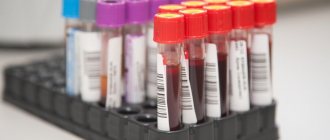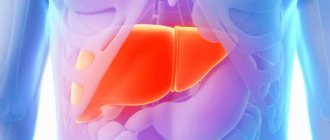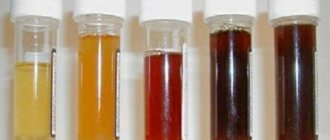The importance of urine analysis for the diagnosis of pyelonephritis
Pyelonephritis is an inflammatory disease caused by infection and affecting the tubular system in the kidneys, intermediate tissue and pelvis. Symptoms of pyelonephritis are similar to other diseases of the urinary system and a comprehensive examination of the patient is necessary to clarify the conclusion.
A urine test for pyelonephritis can reveal the presence of abnormalities in a large number of indicators
An early general urinalysis (UCA) helps determine the nature of the disease: acute, chronic, or exacerbation of a chronic one. This study is also a good way to monitor the body's response to medications. Early treatment prevents the development of more severe consequences, so it is important to take a urine test when the first signs of pyelonephritis appear:
- high body temperature (can reach critical values);
- acute pain in the lower back (usually on one side, but can also occur on both);
- pain and discomfort when urinating;
- cloudiness of urine, the appearance of suspension in it;
- general disorder: weakness, nausea, pallor of the skin.
When taking a urine test, its parameters are determined, the deviation of which from the norm serves as a signal to the doctor about the stage of the disease and its nature.
OAM must be taken throughout the course of treatment to assess its effectiveness, as well as 1–2 weeks after the patient’s recovery
Video: what a urine test shows
Figures and facts about pyelonephritis
The word “pyelonephritis” comes to us from the Greek language. It contains three terms:
- pyelos – “pelvis”;
- nephros – “kidney”;
- it is a word-forming part meaning “inflammation”.
That is, pyelonephritis is an inflammatory disease of infectious origin, which involves the renal cups, its pelvis, and renal tissue.
Pyelonephritis - inflammation of the cups, pelvis and kidney tissue
To understand the scale, seriousness and danger of this process, you need to know some numbers regarding it, namely:
- Every year, approximately 1% of the world's population falls ill with pyelonephritis, which is 70–80 million people.
- Women of reproductive age suffer from kidney inflammation 6 times more often than their male counterparts.
- In all age groups, pyelonephritis is the most common disease of the urinary system.
- Today, this pathology ranks second in frequency among all infectious processes, second only to respiratory diseases.
- Pyelonephritis occurs in 2–12% of pregnant women, and the incidence of such patients has increased fivefold over the past 25 years.
- Life-threatening purulent complications (kidney carbuncle, apostematous nephritis) occur in every third patient with acute pyelonephritis.
- Of all patients in urological hospitals, about half are sick with chronic inflammation of the renal collecting system.
- From sepsis, which often complicates purulent pyelonephritis, 50–80% of patients die.
- In almost every second patient, this disease results in impaired renal function, steadily leading to chronic renal failure.
Unfortunately, pyelonephritis in many cases is not recognized in time. The frequency of errors in diagnosis reaches 50%. The reason for this is the predominance of signs of general intoxication over local symptoms at the early stage of an acute disease. As a result, treatment often begins too late, so the course of pyelonephritis is significantly worsened.
Pyelonephritis is discovered during a pathological autopsy in every tenth person who died for unspecified reasons, and during his lifetime this disease was not even suspected. In people who die in old age, inflammatory changes in the kidneys are detected even more often - in 20%.
It is in connection with all this information that timely diagnosis of pyelonephritis is of paramount importance in urological practice.
Video: what is pyelonephritis
Components of a general urine test
OAM consists of several studies, each of which performs its own task:
- Organoleptic (visual examination) evaluates the clarity of urine, its color and foaminess.
- Microbiological analysis identifies pathogens.
- A physicochemical study determines the pH level and specific gravity of urine.
- Microscopic analysis determines the presence and quantity of salts, erythrocytes, leukocytes, and casts.
- Biochemistry detects protein, bilirubin, sugar (glucose), and blood (hemoglobin) in urine.
Advantages and disadvantages of the method
The advantages of OAM are:
- high information content already at the initial stages of development of pyelonephritis;
- speed of execution (the result becomes known the next day, in emergency cases - within an hour);
- additional assessment of the function of certain other organs;
- ease of implementation;
- low cost.
Special reagents and equipment make it possible to obtain maximum information
Disadvantages of urine analysis may include the following:
- subjective assessment of some qualitative characteristics (for example, color), performed by a laboratory assistant by eye;
- the need to prepare for the analysis for its sufficient accuracy;
- the need for additional research to quantify the parameters.
What tests still need to be taken?
In a general clinical blood test for pyelonephritis, the first thing they look at is the leukocyte formula and the rate at which red cells settle. A significant excess in the number of white blood cells and ESR indirectly indicate the activity of the inflammatory process.
To assess the degree of filtration in the renal tissues, a biochemical study of venous blood is performed. High levels of urea and creatinine are evidence of organ dysfunction.
Preparing for and conducting a urine test
The day before the test, you should follow the recommended rules for preparing for urine testing. In addition to the above contraindications, it is worth paying attention to the following details:
- before donating urine, the patient performs external hygienic treatment of the genitals;
- urine should not be colored due to the patient's consumption of coloring products;
- if you need an urgent urine test during menstruation, it is better to use a tampon;
- urine sampling should occur immediately after waking up (first morning urination);
- It is recommended to use disposable containers for collecting biomaterial purchased at a pharmacy.
The urine container is sterile, does not require pre-treatment and is completely ready for use
In order for the analysis to show the correct result, you must correctly select the average portion of the biomaterial: release urine into the toilet for the first two seconds (about 10 ml), then collect a portion of urine in a sterile container in an amount of 50 to 100 ml, without using any leftovers. Close the jar with a lid and fill the label if necessary.
Characteristics of urine in pyelonephritis
Initially, the main parameters of urine are determined: color, density, smell, presence of blood and protein, acidity. Later, quantitative indicators are determined using instrumental methods.
With pyelonephritis, deviations from the norm of several parameters are observed at once. If only one or two of them are impaired, this may indicate the presence of another disease or the individual characteristics of the patient, and may also be a signal of age-related changes.
Color and transparency
Normally, the color of urine is yellowish, but a slight change in its shade is acceptable (from straw to dark yellow). When the renal pelvis is inflamed, the color of the urine may become pink, red or brownish, depending on the severity of the patient's condition.
Normally, urine is completely transparent. With pyelonephritis, the presence of turbidity in the urine is mandatory, and in severe cases of the disease - small flakes that can be seen with the naked eye.
Cloudy urine is a characteristic symptom of pyelonephritis
Density and acidity
A study of urine during pyelonephritis reveals its reduced density and acidic environment. These indicators change due to the presence of E. coli in the liquid, as well as the phenomenon of polyuria, characteristic of the course of this disease (increased amount of urine excreted).
Smell
When the kidneys are inflamed, a person's urine smells unpleasant. The last sign indicates the development of an infection in the urinary tract. In the absence of inflammatory processes, this physiological body fluid is not characterized by a pungent odor.
Blood
The appearance of blood in the urine (hematuria) is possible in two forms: macrohematuria, when the color of the urine changes to red and is visible to the naked eye, and microhematuria, in which case the appearance of blood cells in it is revealed only during the examination.
The color of urine with pyelonephritis changes depending on the percentage of red blood cells in it
Red blood cells
Normally, the number of red blood cells in the urine ranges from 0 to 3 per field of view. With pyelonephritis, this parameter is exceeded several times. During the OAM process, a laboratory technician examines the liquid using a microscope. In the case of hematuria, red blood cells will be clearly visible.
Leukocytes
An excess of leukocytes in the urine is the main signal of the development of inflammation in the urinary system. In healthy women, their number in the field of view varies from 0–6, in men – 0–3. With pyelonephritis, as the disease progresses, this figure increases, and already on the third day it is more than 10.
Leukocytes in the urine are a clear confirmation of pyelonephritis
Protein in urine
The protein value in a healthy person does not exceed 0.033 g/l. Or there is no protein in the urine at all. During the destructive process occurring in the kidney tissue, proteinuria always develops.
With pyelonephritis, protein appears in the urine, and externally its presence is detected in the form of a white sediment at the bottom of the container and loss of transparency of the liquid, as well as the appearance of its foaminess.
Table: urine parameters for pyelonephritis
| Urine indicators | Norm | Possible deviations with pyelonephritis |
| Color | straw yellow | red (brownish) |
| Transparency | transparent | cloudy |
| Smell | unsharp | cutting |
| pH reaction | pH greater than 4 and less than 7 | pH greater than 7 |
| Density | within 1.012 g/l-1.022 g/l | more than 1.030 g/l |
| Protein | absent, up to 0.033 g/l | 0,5–1% |
| Glucose | absent, up to 0.8 mmol/l | more than 0.8 mmol/l |
| Ketone bodies | none | none |
| Bilirubin | absent | present |
| Urobilinogen | within 5–10 mg/l | more than 10 mg/l |
| Hemoglobin | absent | |
| Red blood cells | 0–3 in the field of view for women, single in the field of view for men | more than normal |
| Leukocytes | 0–6 in the field of view for women, 0–3 in the field of view for men | |
| Epithelial cells | up to 10 in view | |
| Cylinders | absent, single hyaline | presence of granular, hyaline over 20 in 1 ml |
| Salts | none | oxalates in urine |
| Bacteria | present (type) | |
| Mushrooms | ||
| Parasites |
Among the above indicators, pyelonephritis is determined by the excess of leukocytes in the urine - leukocyturia.
The following test indicators for pyelonephritis are important for diagnosis: excess of the norm for leukocytes, deviation in pH, deviation in urine density, presence of bacteria and/or nitrites
Differential diagnosis
In all cases of suspected pyelonephritis, the doctor is faced with the task of distinguishing it from diseases with similar symptoms. Inflammation of the kidneys must be differentiated from the following diseases:
- pneumonia;
- appendicitis;
- glomerulonephritis;
- cholecystitis;
- acute pancreatitis;
- intestinal diverticulitis;
- cystitis;
- sepsis (blood poisoning).
The need for differential diagnosis arises with local hidden symptoms of pyelonephritis. In this case, its most important signs are the presence of bacteria and high leukocytosis in urine. Urine tests need to be repeated several times, since at the onset of the disease changes in this biological fluid may not be visible.
In acute cholecystitis, there are symptoms of peritoneal irritation and pain localized in the right hypochondrium and radiating to the shoulder and scapula.
Unlike acute pyelonephritis, with appendicitis pain first appears in the upper part of the abdominal cavity, and later moves to the lower right region. Symptoms of peritoneal irritation occur. With acute inflammation of the kidneys, the body temperature suddenly rises to 38–39 °C, lasts all night, accompanied by chills and heavy sweat, and by morning drops sharply to 36–37 °C. Appendicitis is characterized by a gradual increase in temperature and its stable maintenance at high levels.
Very often, pyelonephritis is mistaken for glomerulonephritis or cystitis. Here, laboratory tests and clinical symptoms play a decisive role in diagnosis.
Table: distinctive features of pyelonephritis, glomerulonephritis and cystitis
| Signs | Pyelonephritis | Glomerulonephritis | Cystitis |
| Clinical symptoms | |||
| General swelling | Rarely, usually only on eyelids | Often | None |
| Dysuria | Often | Often | Almost always |
| Fever (increased body temperature to 38–39 °C) | Often, during exacerbations | In most cases | Not typical |
| Manifestations of general intoxication | Almost always | Rarely | Sometimes |
| Arterial hypertension | Often | Rare (almost never occurs) | Almost never found |
| Laboratory symptoms | |||
| Proteinuria | Little or no | Significantly expressed | Little or no |
| Hematuria | Not typical | Depending on the stage of the pathological process - erythrocyturia | There may be some bright scarlet blood in the urine |
| Leukocyturia | Pronounced: from 5–7 to 100 leukocytes per field of view | Not typical | Significantly expressed |
| Bacteriuria | Sharply expressed | Absent | Bacteria may be excreted in urine |
Urinalysis according to Nechiporenko for pyelonephritis
Usually, the Nechiporenko method is resorted to only after detecting deviations in the previously passed OAM. This urine test is prescribed by a doctor to identify current pathologies of the excretory system, including pyelonephritis. This type of study reveals the following quantitative parameters of urine:
- number of red blood cells;
- leukocyte count;
- cylinder level.
The content of the above-mentioned formed elements is calculated in a certain volume (usually 1 ml is considered). Only morning urine is collected for the study in accordance with all collection rules in the amount of 50–100 ml.
Urinalysis according to Nechiporenko is performed quite quickly and you can find out the results the very next day. With pyelonephritis, all indicators exceed acceptable standards.
Due to its relative simplicity and high information content, urine analysis according to Nechiporenko has become widespread
Table: urine test indicators according to Nechiporenko for pyelonephritis
| Urine indicators | Norm, quantity in 1 ml | Possible deviations with pyelonephritis |
| Leukocytes | up to 2000 | over the permissible norm |
| Red blood cells | up to 1000 | |
| Cylinders | up to 20 |
Complete blood count assessment
In case of pyelonephritis, it is necessary to determine a number of important indicators that will allow the specialist to adequately assess the situation. The number of red blood cells and hemoglobin in the blood is currently determined automatically using devices. With pyelonephritis, it may well be within normal limits. Low levels are not a direct consequence of the inflammation in the kidneys itself. This situation may be due to damage to the kidney filter, through which red blood cells begin to leak into the urine in large quantities.
Many blood tests are now automated
Erythrocyte sedimentation rate (ESR) is an important property of blood. It is determined in a fairly simple way. The blood is placed in a test tube, after which, after a period of time, the sedimentation rate is recorded using a measuring ruler built into the device. With pyelonephritis, it significantly exceeds the norm.
The erythrocyte sedimentation rate increases significantly against the background of the inflammatory process
The number of leukocytes in the blood is also determined using special devices. Inflammation in the kidneys leads to a significant increase in this indicator. However, it is fundamentally important for the laboratory assistant to determine the leukocyte formula - the detailed composition of white cells. A drop of blood is placed on a special marked glass and examined under a microscope. With pyelonephritis, the number of granulocytes increases, and young forms, which have recently appeared in the blood and are significantly different in structure from mature elements, begin to predominate.
Young forms of leukocytes differ from mature ones
Indicators of a general blood test are normal and with pyelonephritis - table
| Index | Norm | Inflammatory process in the kidneys |
| Total white blood cell count | 5–9 x 109 per liter for adults 7–11 x 109 per liter for children | Above 9 x 109 per liter for adults Above 11 x 109 per liter for children |
| Number of young forms of leukocytes | 2–6% of all white cells | More than 6% of all white blood cells |
| Erythrocyte sedimentation rate | 1–10 mm/hour for men 2–15 mm/hour for women | More than 10 mm/hour for men More than 15 mm/hour for women |
Zimnitsky test
An analysis called Zimnitsky's test allows one to determine whether a patient has renal failure and other pathologies of the excretory system. This study is especially often prescribed for the chronic form of pyelonephritis.
The Zimnitsky test provides an opportunity to identify parameters important for diagnosis:
- the patient’s daily diuresis is the ratio of the volume of fluid drunk and excreted in 24 hours;
- the difference between daytime and nighttime diuresis;
- dependence of the specific gravity of urine on the time of day.
To carry out the analysis, the patient needs to collect urine every 3 hours (8 portions in total, but the doctor may prescribe the collection of 12 portions for a more accurate result). The quantity and density of urine is measured in each volume. Exceeding the normal daily diuresis is a sign of the development of renal polyuria, which is a symptom of pyelonephritis (in this disease, the daily urine output can reach 2000–3000 ml).
With an exacerbation of the disease, the Zimnitsky test reveals a decrease in the specific gravity of urine below 1012 g/l.
The Zimnitsky test allows you to identify disorders in the human urinary system
Table: urine indicators based on the results of the Zimnitsky test
| Indicators | Norm | Possible deviations with pyelonephritis |
| Daily urine volume | 1500–2000 ml | 2000–3000 ml |
| The ratio of nighttime and daily diuresis | 1/3–1/4 | ratio of daytime to nighttime diuresis greater than 3:1 |
| Fluctuations in urine density | 1005–1025 g/l | urine density in all portions is below 1012 g/l |
With the acute nature of pyelonephritis, there is a reverse increase in urine density - over 1025 g/l.
Nocturia (exceeding the ratio of the nighttime volume of urine excreted to the daytime) is also a sign of pyelonephritis, especially in the chronic stage. This symptom can manifest itself over several years, even if other signs of the disease are not obvious, and reflect a weakening of the concentration function of the kidneys.
The Zimnitsky test is the main characteristic of kidney performance. Moreover, the study is easy to carry out and does not require high costs.











